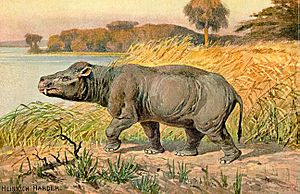Golden Valley Formation facts for kids
Quick facts for kids Golden Valley FormationStratigraphic range: Late Paleocene-Early Eocene (Clarkforkian-Wasatchian) ~57–52Ma |
|
|---|---|
| Type | Geological formation |
| Sub-units | Bear Den & Camels Butte Members |
| Underlies | White River Group |
| Overlies | Sentinel Butte Formation |
| Thickness | up to 122 metres (400 ft) |
| Lithology | |
| Primary | Claystone, mudstone, siltstone, sandstone |
| Other | Lignite, conglomerate |
| Location | |
| Coordinates | 48°30′N 102°42′W / 48.5°N 102.7°W |
| Approximate paleocoordinates | 52°54′N 82°12′W / 52.9°N 82.2°W |
| Region | North Dakota |
| Country | |
| Extent | Williston Basin |
| Type section | |
| Named for | Golden Valley, North Dakota |
| Named by | Benson & Laird |
| Year defined | 1947 |
The Golden Valley Formation is a special layer of rocks found in western North Dakota. It formed a very long time ago, during the late Paleocene and early Eocene periods. This means it's about 52 to 57 million years old! Scientists W.E. Benson and W.M. Laird named it in 1947, after the city of Golden Valley. This rock formation is super important because it holds many amazing fossils. We can find ancient plants, animals with backbones (like mammals and reptiles), and even mollusks and insects here.
Contents
What is the Golden Valley Formation?
The Golden Valley Formation is a series of rock layers found in western North Dakota. Think of them like leftover pieces of a big puzzle. These layers sit on top of the Sentinel Butte Formation. They are also covered by the White River Group, but there's a gap in time between them.
This rock formation can be as thick as 122 meters (about 400 feet). It's divided into two main parts, called "members":
- The lower part is called the Bear Den Member.
- The upper part is called the Camels Butte Member.
What are the Golden Valley Rocks Made Of?
The rocks in the Golden Valley Formation tell us a lot about the ancient environment.
Bear Den Member Rocks
The bottom part of the Bear Den Member is made of kaolin-rich claystone, mudstone, and sandstone. These rocks can be white, light grey, orange, or purple. Above these are grey or brownish rocks that contain lots of carbon. In some places, you can even find a layer of lignite, which is a type of soft coal. This coal layer is known as the Alamo Bluff lignite. Sometimes, the top of this member has a hard, silica-rich layer called the Taylor bed. This layer shows where the ancient ground surface was. The Bear Den Member can be up to 15 meters (about 49 feet) thick.
Camels Butte Member Rocks
The Camels Butte Member, which is the upper part, has different kinds of rocks. It includes montmorillonite and mica-rich claystone, siltstone, and more lignite. You'll also find sandstone that isn't very hard and conglomerate, which is rock made of many different sized pebbles stuck together. The very top of this member often has a thick layer of fluvial (river-deposited) sandstone. This sandstone forms the tops of many of the flat-topped hills, called buttes, in southwestern North Dakota. The Camels Butte Member can be up to 107 meters (about 351 feet) thick.
What was the Ancient Environment Like?
The Golden Valley Formation formed in a huge, swampy lowland. Many rivers and streams flowed through this area. This happened during the late Paleocene and early Eocene periods. This time included a major warming event called the Paleocene-Eocene Thermal Maximum. This means the climate was much warmer than today, perfect for lush swamps and forests.
What Fossils are Found in the Golden Valley Formation?
The Golden Valley Formation is famous for its amazing fossils. They help us understand what life was like millions of years ago.
Ancient Plant Fossils
Scientists have found many plant fossils throughout the formation. These include plants that floated on water or grew rooted in it, like Salvinia, Nelumbo (a type of lotus), and Isoetes. There were also many plants from the lowland forests. These include ferns like Onoclea and Osmunda, and conifer trees like Glyptostrobus and Metasequoia (related to modern redwood trees). Other trees found include Platanus (sycamore) and Cercidiphyllum (katsura tree).
Ancient Animal Fossils
Most of the vertebrate (animals with backbones) fossils come from the upper Camels Butte Member. These fossils show us a variety of ancient creatures:
- Mammals: There are remains of early mammals like Coryphodon (a large, hippo-like animal), Hyracotherium (an early horse), Homogalax (a tapir-like animal), Sinopa, Didymictis, Hyopsodus, and Paramys (an early rodent).
- Other Vertebrates: Scientists have also found fossils of fish, amphibians, and reptiles. These reptiles include turtles like Trionyx, lizards like Peltosaurus, and four different types of crocodilians (alligators and crocodiles).
Ancient Invertebrate Fossils
Even smaller creatures left their mark! Invertebrate fossils include the shells of freshwater mollusks. These are animals like snails and clams, such as Viviparus, Unio, Hydrobia, and Planorbis. Scientists have also found the wing casing of an ancient crabid beetle.


